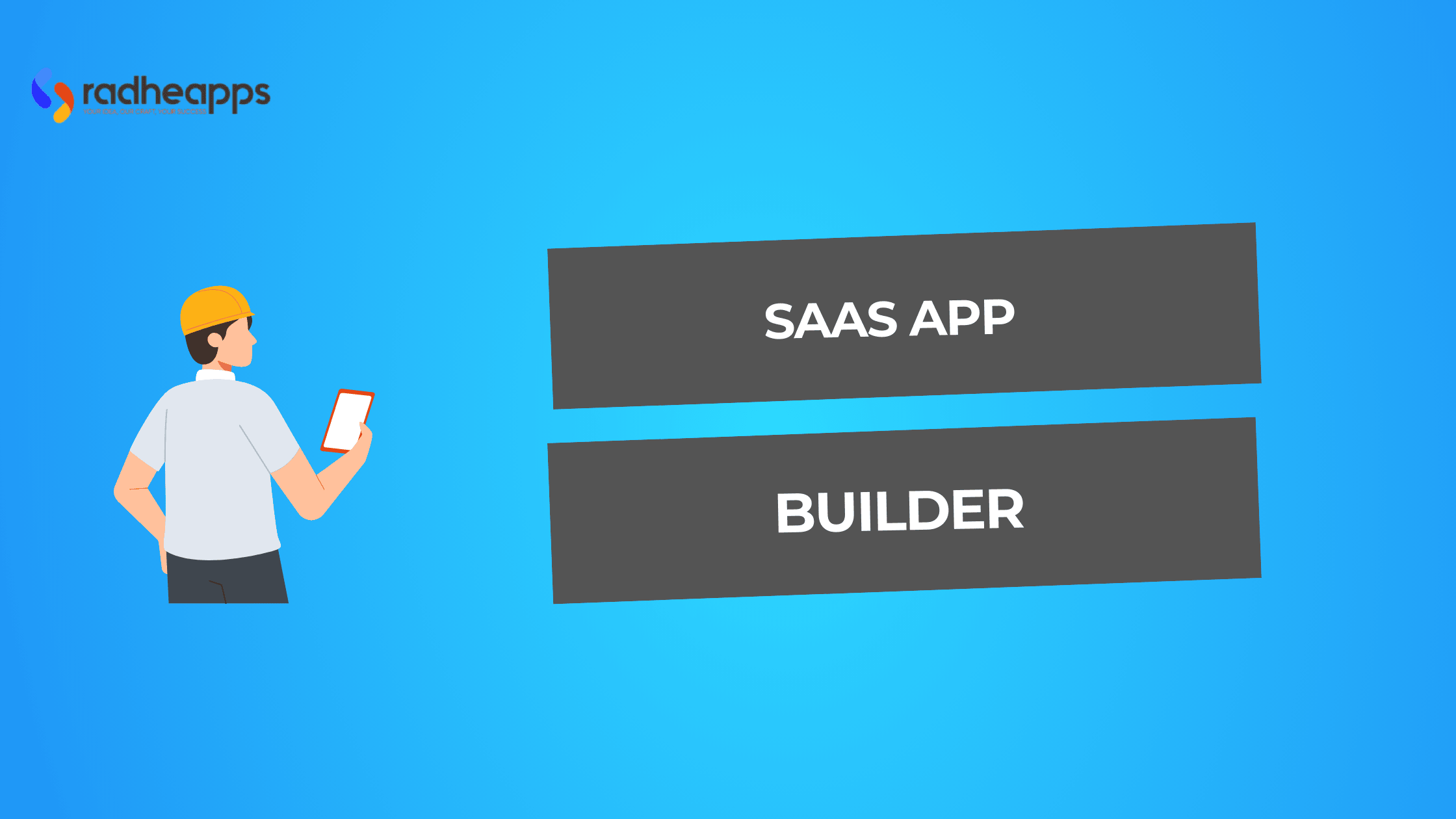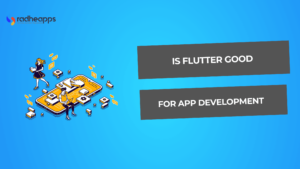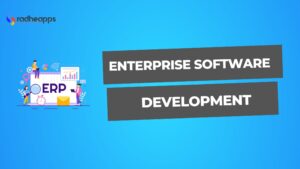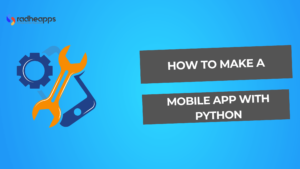Let’s talk about building SaaS apps without coding. Sounds futuristic, right? You’ve got an idea, but coding just feels too much of a hassle. Here’s the good news. No-code tools make it easy to bring your idea to life without writing a single line of code. Perfect for testing your idea or building that first version.
But here’s the catch. No-code platforms can feel a bit limiting when you want something custom or super scalable. That’s where app development experts like RadheApps can help. If you’re ready to level up, we can build an app that fits your business like a glove.
For now, though, no-code tools are your best friend for getting started. So, we’ve compiled a list of top no-code SaaS app builders. Ready to explore? Let’s find the one that’s perfect for your project. And when you’re ready to go big, you know where to find us.
TL;DR – 5 Best SaaS App Builder Tools
In a hurry? here’s a complete list of what you want to jump the queue and get straight to the business:
- Bubble
- FlutterFlow
- Adalo
- Softr
- Draftbit
Want to dive deep? Go ahead and read through the whole blog to find out the best SaaS app builder for your specific needs.
What is a SaaS App Builder?
A platform or service that helps entrepreneurs, developers, or existing businesses create and manage Software as a Service (SaaS) applications without extensive coding knowledge is known as SaaS App Builder.
It streamlines the development process, which allows businesses and individuals to focus on functionality and user experience rather than the underlying technical complexities.
Benefits of Using SaaS App Builders
Streamline App Development Processes:
Rapid Development: SaaS app builders enable faster prototyping and deployment of applications, making it possible for businesses to bring their products to the market faster. Speed here is essential because time to market is one of the significant variables in competitive environments.
User-Friendly Interfaces: Many SaaS app builders provide easy-to-use drag-and-drop interfaces. This makes it easy to create applications for those with minimal or no coding skills. Such interface enables teams to work more on designing user experiences than getting bogged down with technical details.
Reduce Development Costs with No Code SaaS App Builders
Cost savings: The SaaS app builder saves the company from making a front investment in infrastructure and software licenses as it has a subscription-based model. It becomes cost-effective for companies, especially start-ups and small enterprises.
Lower Maintenance Costs: SaaS providers handle maintenance, updates, and security; thus, businesses can save on in-house IT resources and infrastructure costs. This handling lowers operational expenses and allows companies to allocate resources more effectively.
Enhance User Engagement Through Customizable Features
Personalization: SaaS app builders often allow extensive customization options, enabling businesses to tailor applications to meet specific user needs and preferences. This capability enhances user satisfaction and engagement by providing a more relevant experience.
Integration Capabilities: Most platforms integrate with third-party tools and services, allowing companies to expand functionality and build a seamless customer experience. This flexibility is fundamental to adapting to changing market demands and enhancing service offerings.
Key Features of SaaS App Builders
SaaS app builders accelerate the journey from idea to live application. This becomes possible because of some exceptional features. Here are three of them:
Intuitive User Interface
User-Friendly Design: One of the core aspects of SaaS app builders is the focus on an intuitive user interface. The design should allow users to find their way around the application easily.
Thus, it can enhance the overall user experience. A well-structured UI includes clear labeling, logical layouts, and responsive elements that give immediate feedback during interactions.
Mobile Responsiveness: Given the growing number of mobile device users accessing applications, many SaaS app builders adopt a mobile-first approach. It means that applications will work on various devices and screen sizes, thereby reaching a wider audience.
Integration of Landing Pages
Customizable Landing Pages: Most SaaS app builders incorporate the creation of customizable landing pages. Businesses use such landing pages to personalize marketing strategies and enhance user engagement based on the design of a page to branding and message.
API Integrations: Most platforms support integrating third-party services through APIs, allowing connectivity with other systems without a hitch. Such capability is important for enhancing functionality and providing an all-rounded experience to users across different applications.
Android App Builder Capabilities
Cross-Platform Development: SaaS app developers mainly provide the facility for designing Android and web applications. This cross-platform helps businesses reach a wider number of customers by making the availability of services both on web platforms and mobile platforms.
Progressive Web Apps (PWAs): SaaS app builders can develop Progressive Web Apps. It is a combination of the best from both web and mobile applications. It offers offline support, faster loading times, and push notifications, making users more engaged and stick around.
How to Choose the Best SaaS App Builder
It is the right choice for your SaaS app-building tool that will determine the success of your application. That is why it is so essential to choose the right one. Pay close attention to these 8 points to make an informed decision:
Define Your Business Requirements:
Define the objectives and problems your application can solve before getting into SaaS app builders. Understanding your target audience and the functionalities you are looking to build will guide you in searching for the appropriate builder who aligns with your aims.
Evaluate Ease of Use:
Find a platform with a user interface that makes development easier and straightforward. An easy-to-use interface can help non-technical users develop something by making the platform easier to navigate. This leads to faster development time and lowers the learning curve.
Assess Integration Capabilities:
Choose a SaaS app builder that supports seamless integration with other tools and services. This feature can be essential for enhancing functionality and ensuring your application can communicate well with systems already in place.
Check Customization Options:
Customization of features is essential to tailor your application to meet specific user needs. Ensure that the builder allows for extensive customization that enables you to create a unique user experience that resonates with your audience.
Review Portfolio and Case Studies:
Examine the builder’s portfolio for the experience and expertise to develop applications like yours. Case studies will give you an idea of their capabilities and the quality of their previous work; you can judge whether they can fulfill your needs.
Consider Scalability:
Choose a SaaS app builder that grows with your business. It should be able to support increased user loads and data management without losing performance and ensuring long-term viability.
Examine Security Features:
Data security is a very important factor in SaaS applications. The builder should have robust security measures that include data encryption, compliance with regulations (such as GDPR), and regular security updates.
Look for Support and Community Resources:
A good support system is necessary for troubleshooting and guidance during development. Ensure the platform provides customer support, documentation, tutorials, and an active community forum where users can share insights and solutions.
List of 5 Best SaaS App Builder Tools – No Code Solutions
Endless tools in the market help you build SaaS tools from scratch without any coding. Let’s help you find the best one for your business idea.
1. Bubble
Bubble is a no-code platform that lets you build web and mobile apps without writing a single line of code. Yep, you heard that right. Whether you’re a business owner, an entrepreneur, or just someone with a cool app idea, Bubble helps you design, build, and launch apps from scratch. It’s like having your own full-stack developer, but it’s way easier to work with.
Bubble stands out because it’s simple, powerful, and flexible. You get full control over how your app looks and works. Plus, it’s built to grow with you, so you don’t have to worry about scaling when things take off.
Here’s what makes Bubble a top pick:
- No-Code Tools: Drag-and-drop tools make app-building super simple. You don’t need to be a tech genius to create something awesome. Buttons, workflows, layouts—you name it, it’s all there.
- Customization: You can completely customize your app’s look. Want it bold and flashy? Minimal and sleek? Go for it. Add dynamic content and logic to make the app feel alive.
- Scalable: Bubble’s infrastructure can handle everything from your first user to thousands. Built-in hosting, real-time backups, and solid performance? Check.
- Built-In Growth Boosters: SEO tools, analytics, and plugins are ready to help your app get noticed and keep users happy.
- Team-Friendly: Multiple people can collaborate on your app in real-time. You can even tweak who has access to what. Perfect for teams.
Bubble has a plan for everyone. Here’s a quick rundown:
- Free Plan: Great if you’re just starting or want to experiment.
- Starter Plan ($29/month): Best for launching small apps or testing ideas.
- Growth Plan ($119/month): Ideal for growing apps with features like custom domains and more capacity.
- Team Plan ($349/month): Perfect for businesses and teams who need serious app power.
- Enterprise Plan: Custom pricing for organizations with big needs—think security, scalability, and VIP support.
If your app grows faster than expected, you can add extra capacity anytime.
2. FlutterFlow
FlutterFlow is like a cheat code for app development. It makes building apps simple, fast, and even fun. Whether you’re a developer, designer, or just someone with a great idea, FlutterFlow lets you turn it into a mobile or web app without breaking a sweat. It’s built on Google’s Flutter framework, so you get apps that run smoothly on both iOS and Android. The best part? You don’t need to be a coding wizard to make it work.
Here’s what makes FlutterFlow:
- Drag-and-Drop Builder: Forget spending hours coding layouts. Just drag, drop, and design.
- Powered by Flutter: It uses Google’s Flutter framework, so your apps are fast and look amazing.
- API Ready: Connect your app to external services with ease. Some plans even support unlimited APIs.
- Advanced Features: Want push notifications or payment options? You’ve got them. It even supports multiple languages.
- Team Collaboration: Work with your team in real time. Version control and shared access keep everyone in sync.
- Easy Deployment: Publish directly to app stores or export code if you want more control.
- Customization: Tweak everything—themes, layouts, animations—to make your app look professional.
FlutterFlow has plans for everyone. Here’s a quick breakdown:
- Free Plan: Great for experimenting and learning the basics.
- Standard Plan ($30/month): Perfect for building real apps with advanced design tools and API integration.
- Pro Plan ($70/month): For serious projects. Includes custom functions, payment integrations, and support for teams up to 20.
- Team Plan ($70/user/month): Ideal for larger teams with unlimited API endpoints and access management.
No matter the plan, you get access to core features, and higher plans unlock advanced options for scaling and customization.
3. Adalo
Adalo makes building apps easy. You don’t need to know how to code. It’s perfect for anyone who wants to design, build, and launch apps for mobile or web quickly. It’s user-friendly and works for beginners, startups, and even businesses looking for a professional touch without all the hassle.
Adalo gives you everything you need to create fully functional apps without hiring developers. Its drag-and-drop interface makes things super simple, even if you’ve never built an app before. Plus, it’s packed with tools that make your app look and work like it was built by a pro.
Key Features:
- Drag-and-Drop Builder: No coding needed. Just drag, drop, and design. Add buttons, forms, and images easily.
- Built-In Database: Manage your data directly inside the app. No extra tools needed.
- Publish on iOS & Android: Adalo lets you publish your app to both platforms without extra work.
- Custom Actions & APIs: Want to go advanced? Connect external tools and create custom workflows.
- Component Marketplace: Need extra features? Grab pre-built tools like calendars, maps, or payment options.
- Team Collaboration: Working with others? Share projects and work together seamlessly.
Adalo offers flexible plans so you can pick what works best for your project:
- Free Plan
Play around and build prototypes. Great for exploring but limited to previews. - Starter Plan ($36/month)
Ideal for smaller projects. Publish to one platform. - Professional Plan ($52/month)
Best for growing apps. Publish to iOS and Android and unlock advanced features. - Team Plan ($180/month)
Made for larger teams working on multiple projects. - Custom Plans
Perfect for businesses with specific needs. You’ll get a plan tailored to you.
Every plan includes core features like the drag-and-drop builder and basic database tools. Want advanced stuff like custom APIs? Go for the higher-tier plans.
4. Softr
Softr lets you turn Airtable or Google Sheets into fully functional web apps and client portals. No coding. No headaches. Just drag, drop, and go. It’s perfect for freelancers, entrepreneurs, or teams who want professional results without the tech struggle.
Here’s why Softr stands out:
- Instant Airtable and Google Sheets Integration: Plug in your data and watch it come to life in real-time. No manual syncing.
- Pre-Built Templates: Launch apps fast with ready-made blocks. Need an e-commerce store? Membership portal? Project tracker? They’ve got you.
- Drag-and-Drop Design: Customize every detail to match your style. No design skills? No problem.
- User Permissions: Add role-based access to keep your apps secure.
- Powerful Extras: Workflows, custom domains, analytics, email integrations—you name it.
- Hosting Included: Softr handles all the hosting, so you don’t need extra tools or infrastructure.
- Collaboration Features: Build with your team in real time. Stay on the same page and get things done faster.
Softr’s pricing works for all budgets. Here’s a quick breakdown:
- Free Plan: Perfect for testing the waters. Build simple apps with basic features.
- Professional Plan ($49/month): Great for small teams or anyone who needs custom domains and advanced features.
- Business Plan ($199/month): Ideal for growing businesses that need workflows, better security, and more data capacity.
- Enterprise Plan (Custom Pricing): Big team? Big goals? Get a custom setup and dedicated support.
Every plan includes hosting, Airtable integration, and pre-built blocks. The paid plans unlock even more tools to help you scale.
5. Draftbit
Draftbit lets you build mobile apps without writing a single line of code. It’s all about precision and flexibility. You get a drag-and-drop interface to design your app, plus full access to the app’s React Native source code. Why’s that cool? It means you can tweak and scale your app however you want, even after it’s built.
It’s perfect if you’re looking for something easy to use but powerful enough to grow with your needs. You get the simplicity of no-code tools combined with the control of coding.
Here’s a quick rundown of the features:
- Visual Builder: Drag and drop to create your app. No coding required.
- Source Code Access: Download your app’s React Native code and customize it as much as you like.
- Custom Components: Add unique layouts and features to make your app stand out.
- Collaboration Tools: Work with your team in shared spaces. Perfect for group projects.
- Test and Deploy: Test your app right in the browser. Then, publish it to the App Store or Google Play.
- Advanced Features: Connect APIs, create custom functions, and use reusable blocks for complex apps.
- Expert Services: Need extra help? You can get expert support to build or improve your app.
Draftbit has plans for everyone, from beginners to big teams.
- Free Plan: Great for exploring. Includes basic features and a few draft apps.
- Basic Plan ($19/month): Perfect if you’re working on a single app. Includes 1 published app and API integrations.
- Pro Plan ($59/month): Need more? This plan offers unlimited draft apps, multiple published apps, and custom code access.
- Team Plan ($199/month): Built for teams. Get shared workspaces, unlimited collaborators, and more advanced features.
Specialized Plans for Bigger Needs:
- Freelancer Plan ($99/month): Made for freelancers managing client projects.
- Agency Plan ($299/month): For agencies handling lots of apps.
- Enterprise Plan ($995/month): Custom solutions with premium support.
Want hands-on help? Draftbit’s Expert Plans (starting at $2,000/month) connect you with pros to build or improve your app.
Steps to Build Your App with a SaaS App Builder
Making an app using a SaaS app builder can be such a streamlined process that it allows you to have functional applications without needing huge coding knowledge. Here’s a step-by-step guide to help you navigate this development journey:
Confirm Your Idea’s Viability:
Begin by validating your application idea through market research. Identify your target audience, analyze competitors, and understand user needs. This basic step ensures that your app addresses a real problem and has potential demand.
Define Project Scope and Features:
Determine the core features your application will offer. Focus on the minimum viable product – the simplest version of your application that can still provide value to users. Think about prioritizing features based on your user needs and business goals.
Select the Right SaaS App Builder:
Choose one SaaS app builder among the ones that meet the requirements. Compare them through ease of use, capabilities for customization, integrations it can support, and scalability capabilities. Certify your selected platform supports all the particular functionalities you will need.
Design Your Application:
Sketch out wireframes or prototypes to visualize the layout and functionality of your app. Design an intuitive interface that would enhance user engagement and satisfaction.
Technology Stack:
Based on the capabilities of your chosen SaaS app builder, select appropriate technologies for both the frontend, for example, HTML, CSS, JavaScript frameworks, and the backend, for example, Node.js and Python. This choice will impact your app’s performance, scalability, and security.
Develop the Application:
Utilize No-Code Features: If using a no-code platform, use drag-and-drop tools to build your application without writing code. Include functionalities like payment processing or user authentication when needed.
Testing and Feedback:
Before releasing the application, test it to identify bugs or usability issues. Take feedback from potential users during beta testing, refine features, and enhance the user experience.
Deployment:
Once testing is complete, deploy your application to a reliable cloud service provider. Ensure you have a plan for attracting early users, such as offering free trials or promotional discounts.
Post-Launch Support and Maintenance:
Monitor Performance: After launch, continuously monitor the application’s performance and gather user feedback for ongoing improvements. Regular updates and maintenance are crucial for retaining users and ensuring long-term success.
Best Practices: SaaS App Builder Potential
The best SaaS app builders leverage best practices to power swift transitions from concept to functional application. Here are eight of them:
Strategic Feature Prioritization:
Identify Core Features: Begin by defining the core features of your Minimum Viable Product. Focus on the most crucial functionalities for launching your product and gathering user feedback. This approach will help validate your concept before full-scale development.
Create a Product Roadmap: Develop a clear product roadmap that defines milestones and goals for your SaaS application. It should outline the development process but allow flexibility to adapt to market changes.
Adopt Agile Development Methodologies:
Iterative Development: Use agile methodologies such as Scrum or Kanban for iterative development. It is a rapid series of changes with the help of user feedback and moving market trends so that with each release, value is added.
User-Centered Design:
Interactive User Experience: Develop a simple UI that makes the user experience interactive. Add functionalities like easy onboarding, informative dashboards, and consistent patterns to make it more user-friendly.
Accessibility: Ensure your application is accessible, which means it is usable for all users, including those with disabilities.
Modular Architecture:
Modularity for Flexibility: Design for a modular architecture so that some components can be built, tested, and scaled separately. This modularity enables flexibility and scalability; you can easily adapt to changing requirements.
Scalability:
Plan for Growth: Design your application with scalability at its core. This also entailed choosing the right cloud services and technologies that handle increased user loads without interfering with the performance.
Integration Strategy:
Third-Party Integrations: Develop a clever integration strategy to connect your application with third-party services for functionalities such as payment processing or content management. It saves many resources compared to having everything built from scratch.
Data Management and Security:
Strong Data Handling: Adopt efficient data management practices and ensure that robust security measures are designed to protect user data. Update the security protocols from time to time to address new threats.
Automated Testing and Continuous Deployment: Include automated testing in your CI/CD pipeline for code quality and reliability. It helps continuously deliver updates.
Customization Options for Users:
Personalization Features: Users can customize their experience through flexible dashboards or templates. Self-service features can also reduce reliance on customer support, enhancing user satisfaction.
Conclusion
No-code SaaS app builders have completely changed the game for entrepreneurs. They make it simple to turn your ideas into apps, test them out, and hit your first goals without needing to be a tech wizard. Want to build a basic app or an MVP to get your business rolling? These tools can make it happen fast.
But let’s be real. As your SaaS grows, these platforms might start to feel limiting. You could run into issues with scalability or need features they just don’t offer. That’s where RadheApps steps in. We specialize in turning big ideas into custom, scalable apps built around your exact needs. We’ve got your back if you’re ready to push past no-code limits and build something truly next-level.
Use the tools to get started. Then, when it’s time to grow, let RadheApps bring your vision to life. Ready to take that next step? Reach out to us today!
Frequently Asked Questions (FAQs):
What is a No-Code SaaS App Builder?
The SaaS platform that allows users to create SaaS apps without the need for traditional programming skills is called no-code SaaS App Builder.
How Does a SaaS Online App Builder Work From a Website?
A SaaS online app builder operates through a web-based platform where users can access tools and resources for app development.
How Can Landing Pages Improve SaaS App Engagement?
The SaaS apps’ landing pages should capture users’ internet, facilitate lead generation, and provide a clear call-to-action if they want to improve any parameter via their landing page.
What are the Cost Benefits of Using SaaS App Builders
Reduced development costs, lower maintenance, and subscription-based pricing are some of the cost benefits that SaaS App Builders offer.




